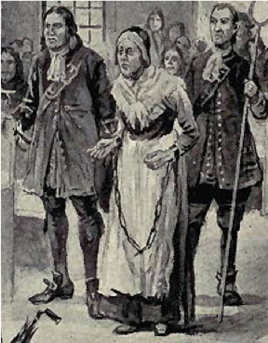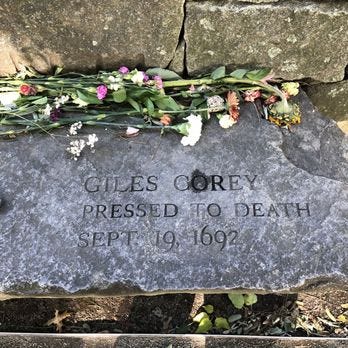If you're creepy and you know it, clap your hands!
I don't mind saying that this is a good one.
The Melon Heads
Have you ever heard of the Melon Heads? I hadn't until a few years ago when I came across the name while looking at regional cryptids. Of course the name caught my eye because it sounds like a delicious round candy of the “pass the box of Melonheads” type. But no, Melon Heads, the kind we're discussing here, are nothing you'd want to suck on.
They are small creatures with big, round heads, the kind usually attributed to hydrocephalus, the condition seen in babies who suffer from a build-up of fluid on the brain.
Which reminds me of the time when my family was in line outside the Knott's Berry Farm chicken restaurant in Buena Park, Ca. My sister was holding her son, who was about a year old at this time. She and I were talking, I don't remember about what, but not about the boy, when the woman standing in line in front of us suddenly turned round, looked at my nephew, and cheerfully said, “Oh, don't worry about his head, it'll look normal as he gets older!”
Melon Heads are children or very small adults, and they attack like rabid ferrets. Some stories even say they eat their victims. Though the stories tend to have some major plot points in common, one of the strangest things about the Melon Heads is that they populate the woods of Michigan and Ohio, then skip over several states to appear in Connecticut. Did they rent a car?
In the northernmost area for sightings, the Melon Heads are said to populate the woods surrounding a yellow brick home called the Dorr E. Felt Mansion in Holland, Michigan. It's a beautiful three story home built with the fortune that came from Felt inventing the precursor to the calculator/office processor, called the Comptometer. The house is on the Register of Historic Places and is now a tourist destination. The family sold the home during WWII, and legend has it that nearby was the Junction Insane Asylum, which housed a group of children who suffered from hydrocephalus. One day, these children killed their doctor, and then, they cut him into chunks! But they didn't stop there. They hid the doctor chunks all over the asylum, creating the worst Easter egg hunt ever. The staff released the killers into the woods and they remain there waiting for delicious people to come along.
County records don't show that there was ever a Junction Insane Asylum, or any other asylum, in the area, but obviously that's because a local official with something to hide burned the paperwork decades ago.
In Ohio, the favored hangout for Melon Heads is also specific. They prefer the Kirtland suburb of Cleveland with it's lovely old places of worship, it's cozy crackerbox houses, and it's murder cult. The story here is that a Dr. Crow (the spelling has a whole handful of variations, and sometimes the storyteller just says, fuck it, and calls him “Dr. Melonhead”) somehow acquired a bunch of orphans to experiment on, and he tinkered around until he ended up with hairless, bulb-headed kids. Which is... what he wanted?
The children eventually killed the doctor, and you guessed it, ran into the woods to hunker down and eat travelers.
Now we get to Connecticut, and why the Melon Heads didn't establish colonies in Pennsylvania or New York, I can't say. There seems to be plenty of Melon Heads, so why not a Hamptons branch?
The Connecticut story differs from the Midwest stories in some important ways: they are adults and they are everywhere. It begins with the Melon Heads, all adults, being housed in an institution for the criminally insane. The institution caught fire, and while the Melon Heads got out of the burning building, the entire staff perished, leaving up to 20 patients to fend for themselves in the woods. They resorted to the two most obvious activities: cannibalism and makin' more Melon Heads. Territorial to a fault, the Melon Heads are still out there in the woods all over Connecticut, squatting and waiting to catch some human dinner.
There is another variation on the Melon Head story around these parts, as some say they are the inbred descendants of Colonial-era witches. I really didn't need to say “inbred” though, did I? You already knew.
SPOOKY BOOKY
A little zombie romance
I'm walkin'
yes indeed
and I'm talkin'
'bout you and me
and I'm hopin'
that you'll come back to me
Fats Domino
For most of us, death is the end of our love life. Flirting, done. Tinder account, deleted.
Not so fast, bucko. We're going to look at two books that explore the subject of love among the living dead.
What's in a name? That which we call a rotter by any other name would still smell as rank.
Warm Bodies by Isaac Marion
'R' is a zombie wandering around an abandoned airport with lots of other zombies, not doing much. But he remembers a little more about being human than most zombies and has cobbled together a family consisting of a zombie wife and zombie kids. He has a best friend. He listens to Sinatra. He wants to feel the way he used to, when he was human.
And then he sees the lovely human Julie and saves her from being eaten by his zombie friends. Taking her to safety, he and Julie find a connection, despite knowing that his friends want to eat her and her friends will shoot him. This is Apocalypse Romeo and Juliet.
Breathers by S.G. Browne
Another undead experience seen from the zombie's POV.
Andy fell asleep at the wheel and ended up killing both himself and his wife, but where she stayed dead and buried, Andy stayed down only long enough to be embalmed. That slowed down the decaying process considerably.
Now Andy hides from the world, and his enraged father, in his parent's basement. There he guzzles wine, watches tv, and tries to deal with his depression. A percentage of the dead population has been rising for decades but zombies are reviled. They have a curfew, are banned from driving or using the internet, and it's legal to assault a zombie. No wonder Andy's depressed. The only place he's treated like he matters is at the Undead Anonymous meetings, where he gets a little therapy and meets Rita, the love of his afterlife.
Curses!: The Sheriffs of Salem
People just don't curse each other the way they used to. They'll cuss each other, for sure, but they aren't calling on a higher power to see that an enemy roasts for all eternity in a fiery pit, let alone asking for the enemy's children and line of descendents to keep them company in the red hot flames of Hell. There was a time when the phrase God damn you wasn't just thrown around, you wanted the person you were directing it at to be damned in Hell.
Well, I have a story about a curse that was so sincere that it appears to have lasted for 300 years.
The place is Salem, Massachusetts, and the time is that of the Salem witch trials, specifically, 1692. Farmer Giles Corey had been vocal about the witch trials taking place in his city. He was all for it. Until his wife, Martha, was accused and arrested, then Giles suddenly decided that not all of the accused witches were guilty. He began speaking out against the trials even though he knew this was the most dangerous thing to do, and it took very little time before he too was arrested for witchcraft.
Martha was Giles' third wife, as he's outlived his previous two. They had married in 1690 when Giles was 80 years old, an age that was a real accomplishment to reach. He had grown children, and Martha had at least one son when they married. Though Giles had mellowed into a respectable farmer in his advanced age, he had an unsavory event in his past that had brought him before local officials on the charge of “unreasonable force” fifteen years previously. Giles had beaten an indentured servant named Jacob Goodall with a stick for stealing apples from Giles' brother-in-law. Giles beat Goodall so severely that the man died from his wounds, though he might have lived if Giles hadn't compounded the beating by waiting ten days before calling for a doctor. Since beating a servant was legal, Giles was charged with “unreasonable force” rather than murder. Multiple witnesses were called to testify, Giles was found guilty, and fined.
When Giles was arrested for witchcraft in 1692, he was 81 years old. The law required the accused to enter a plea of innocent or guilty before a trial could take place, which is why Giles refused to say anything. He would not enter a plea, which is why Sheriff George Corwin decided to take a more hands-on approach. Corwin was just about 27 years old at this time, and he was married to Susanna Gedney, daughter of witch trial judge Bartholomew Gedney, which may have made Corwin even more motivated than usual. While the accused prisoners suffered many types of torture, including starvation and burning, Corwin decided to press Giles in order to force him to enter a plea.
Giles was laid on the ground and a wooden board was placed over him. To this, heavy stones and weights were loaded on top. Giles reportedly only said “more weight” or “more stones”, which would have been taken as a taunt to Corwin, who stood on top of Giles and the heap of stones on more than one occasion. Over two days, Giles never entered a plea or even begged for the torture to end, but he did look at Corwin and croak, “Damn you, I curse you and Salem.”
One witness to his torture was a cloth merchant, writer, and witch trial denouncer named Robert Calef, who wrote, “In the pressing, Giles Corey's tongue was pressed out of his mouth. The Sheriff, with his cane, forced it in again.”
Giles died, the only victim of the trials to be pressed to death.
And here's another particular of Salem law back then: because Giles didn't enter a plea, he couldn't be brought to trial, and that meant that he couldn't be found guilty of witchcraft, and that meant the government (the judges) didn't get to take Giles' property and land. If he had been found guilty and executed, as he most likely would have been, all his worldly goods would have been taken from his family, but because he remained silent, his children inherited what was his, a fact that Giles surely knew and held onto as he was dying.
Martha was hanged as a witch three days after Giles expired.
But Corwin was suffering from a hurt ego after Giles died without a plea. Years after both her father's death and Corwin's, Giles' daughter Elizabeth reported that, after murdering her father, Corwin came to the family home and threatened to take everything the Coreys had as a matter of law, a bluff that worked. He was given 11 pounds and six shillings, a tremendous sum, and he went away.
Twenty years after Giles' horrible death, he was officially absolved of being a practitioner of witchcraft. Martha's son had to wait even longer. He petitioned the courts in 1723 for the illegal execution of his mother and was awarded 50 pounds in damages.
But some believe that Giles got the last laugh, because within four years of being cursed, Corwin died of a heart attack. That might have been thought a natural death if Corwin had been older, but he was either 30 or 31 years old when he died. The Curse of Giles Corey had begun.
Over the next 300 years, it's said that nearly every Sheriff of Salem was struck by either heart attacks or blood disorders. It wasn't until 1978 that one Sheriff named Robert E. Cahill began digging into the history of the curse. Cahill had recently been forced to resign his position when he was struck by both a heart attack and a rare blood disease. His research showed that his predecessor, Roger E. Wells, also had a rare blood disorder, and the sheriff before him, Wells' father Earl, had died of a heart attack while holding the position. Going through a list of Salem sheriffs, I counted six who had died in office. In a 300 year span, that's not bad at all, and several had survived the office and gone on to live long, successful lives.
The curse is believed to have been broken in 1991 when the Sheriff's office was moved nine miles outside of Salem to the town of Middleton, though the man who held the office at the time of the move may not think so. Charles Reardon was the sheriff of Salem from 1978 to 1996. He was in such good health that he was able to really give it his all in pursuing a breath-taking list of illegal extracurricular activities while in office. His convictions included conspiracy, corruption, and using the jail address to receive mail-in bribes.
I couldn't let the passing of Lori Loring, the original Wednesday Addams, go without notice.
Next week: Shine up your biggest ladle, 'cause we're ready for the upcoming maple festivals! Yesyesyes!
We're also delving into the curse of Macbeth (if I survive saying his name), and get all squirrely over a little Stephen King news.
There's a lot of great stuff coming next week, but only for those clever subscribers who have tipped $5 for a whole month of all this rare entertainment. Well worth it, I say!

















